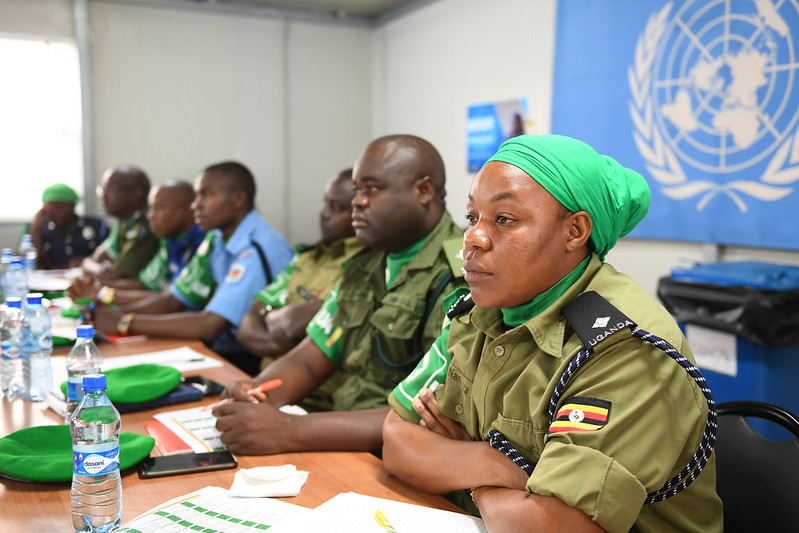New Somalia-AU post-AMISOM proposal silent on financing and overly ambitious

By T. Roble
GOOBJOOG NEWS|ADDIS ABABA: The African Union may drop its earlier proposal for AU-UN Multidimensional Stabilization Mission in Somalia and instead accede to a compromise AU-led transitional force fronted by Mogadishu which will see a near same version of AMISOM operate for two more years in the country should a new joint technical committee agreement sail through.
A meeting by the AU Commission, AMISOM and Somali government between January 7 and 22 proposed the adoption of an African Union force similar to AMISOM to lead a two-year transition which culminates with the hand over of responsibilities to the Somali Security Forces on December 2023.
According to the pact signed by the Director-General in the Ministry of Defence Hussein Samatar for Somalia and Zinurine Alghali on behalf of the African Union, the new outfit, African Union Transitional Mission in Somalia (ATMIS) will conclude its operations in Somalia in December 2023 but based on ‘prevailing conditions’.
ATMIS, the proposal indicates will undergo a four-phase transition culminating in the full transfer of responsibilities to SSF.
Reinforced Command
In terms of composition, the ATMIS will be multidimensional just like AMISOM having military, police and civilian components. The force, the pact notes, will be headed by a force commander from the country with the highest number of troops ‘proposed by the Federal gOvernment’. However, this proposal is likely to face headwinds from Troops Contributing Countries (TCC) and the AU itself which has demanded independence from the Somali government.
Another contentious issue arising from the proposal is the financing of the ATMIS which the joint technical committee paid little attention to. While the committee notes that the funding should be sustainable and predictable, it does not explicitly indicate how it intends to address this issue which has for the longest bedevilled AMISOM.
The AU proposal which was endorsed by the African Union Peace and Security Council on December 10, 2021, sought to deal with the financing uncertainty by placing responsibility on the shoulders of the UN Security Council. Similar to financing is the provision of force enablers and multipliers which TCCs have severally complained of not being availed. The joint proposal does not also address itself to this issue.
READ ALSO: AU Security Council okays hybrid force amid Somalia’s objection
AU report endorses AU-UN Hybrid Force in Somalia
Financing
Given shrinking fund and donor fatigue informed by domestic pressures and competing demands in other global theatres, a post-AMISOM outfit not guaranteed funding through the UN Security Council could face even more uncertainties and unlikely to attract contributions from TCCs.
AMISOM operates on an estimated $900,000 million annual budget. This budget is comprised of funds from the EU which pays stipends to the current 19,000 force. The UN provides logistics and other operational costs while the US handles the training component. Coordinating this kind of budget and ensuring sustainability and predictability is no mean feat. Security experts have strongly opined against this model noting it cannot be replicated in other theatres owing to its complexity. For the AU and TCCs therefore, retaining the same model for another phase which will almost spill into the third and even fifth year could prove untenable. Of further note also is that deploying a strained and weakened force to replace AMISOM gives Al-Shabaab and other opposition armed groups an upper hand and more leeway to stabilise their grip and rule.
Shared risks
The joint committee also proposes that ‘TCCs should agree to share risks and opportunities across all sectors by responding to emerging or ongoing threats.’ Though the committee did not set out the number of forces that will form the ATMIS (another oversight), it should be understood that it will be much leaner than the current form meaning that TCCs will not be willing to stretch their forces within vast operational theatres.
The two-year transition window is also another contentious issue that may not pass the reality test. The technical committee argues that the ATMIS should work in conformity with the revised STP which envisages the assumption of security responsibilities from the AU forces by December 2023. The first STP adopted in May 2018 reached its sell-by date in December 2021 with very few results to show.
While the need for a Somali takeover is overarching and overdue, prospecting on a quick turnover against the backdrop of thinning resources is foolhardy. It should also not be lost on many an observer that the current administration in Villa Somalia is grossly ill-placed to negotiate a security deal. This is an administration that has largely been driven by populist nationalism pushing a disingenuous ‘Somali-led’ process following continued international isolation.
In fact, by opting for an AU instead of a hybrid AU-UN force, Villa Somalia is hoping to secure itself a more friendly, ‘homely’ force which it can enter political deals as it has done with AMISOM in the recent past. Outgoing President Mohamed Farmaajo is looking at a new term in office with less international oversight and a more amenable foreign force to work with.